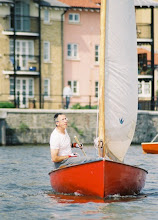
This picture shows the three ages of the Finn rig. The first masts were wooden with initaially cotton sails then terylene. K197 has a Bruder mast and an Elvstrom sail, dating from around 1964. From 1972 alloy masts became common and GBR 417 sports a Needlespar 3M mast with a Hood sail. GBR shows the modern era, a Pata carbon wing mast with a mylar sail.
The basic maxim is that a heavy guy needs a stiff mast and a lighter guy a softer mast. However the combination of sideways and fore and aft bend has occupied whole careers! In addition it’s very important that the sail matches the mast bend so it’s normal to buy them together, whether new or second-hand.
For UK classic finns, Collar wooden masts, made at Oxford, were the basic club level Finn masts, rather stiff and heavy.
Bruder masts from Brazil were the very best wooden masts, winner of the Gold Cup many times.
Boyce wooden masts were very successful in the last days before aluminium came in. After 1972 John Boyce at Burnham-on-Crouch also made aluminium masts, using an oval tube, cut and welded at the top to produce the taper. Very successful in the OK class they were never very common in Finns.
Needlespar masts were boldly selected for the Olympic games in 1972 to reduce the variability of the wooden masts supplied to the competitors. (All Finns were supplied for the Olympics by the host country). The early masts (Needlespar 3B) were oval tubes at the bottom with a series of reducing diameter tubes for the top mast, glued together and turned down on the outside to provide a smooth taper. These masts were rather stiff so only suited the heaviest helms. Later the bottom section was also round (Needlespar 3M), but with thicker walls at the side than fore and aft. Different bend characteristics could be achieved with shorter or longer top masts, to produce stiffer or softer masts as required. The bend characteristics can therefore be guessed at by measuring the height of the top mast join. Needlespar also produced a few softer Delta masts with a D section bottom tube. These were standard for the Lightening 368 class.
Mast bend characteristics are usually defined by supporting the mast at the base ring and deck ring then hanging a fixed weight from the top. Bend is then measured at the top, half and quarter heights. Both sideways bend and fore and aft can be measured in this way.
In the days of wooden masts it was generally accepted that mast bend could be selected to suit a wide range of helm weights. However masts varied a lot and so much adjusting and swapping of masts took place to get a fast mast.
Aluminium masts introduced much greater reliability and mast selection became much less of an issue. However alloy masts were generally much stiffer and so lighter helms (less than 15 stone) became less competitive.
Since the early 90s carbon masts have become dominant. Initially these had very similar bends to alloy masts but they have now developed to have a much more even bend between the black bands, with extra bend being either below the bottom band or below the deck. A claimed advantage of carbon masts is that it has re-introduced the possibility of softer masts for lighter helms.
The matching of a sail’s luff curve to the mast bend characteristics has always been a Finn art from the earliest days when Paul Elvestrom realised its importance.
In the late 60s and early 70s many club sailors used Seahorse or Banks sails on a Collar mast, with Musto sails becoming popular, often with a Boyce wooden mast. The top sailors were probably using Bruder masts with Elvestrom or Raudaschal sails
With the introduction of alloy Needlespar masts Musto initially were the common sailmaker but from the mid 70s onwards North became dominant. Musto continued Finn sail development however right up to the present day and have always produced fast sails alongside North. No other sail maker in the UK has invested as much in development as these two sailmakers so with the odd exception (say Sobstad for early plastic sails) no other sailmakers have managed to produce significant numbers of fast Finn sails.
Sail selection for the classic Finn owner is a bit of a problem because of course no-one still makes sails for alloy masts, let alone wooden ones.
The problem is that the bend characteristics are quite different between different masts. The Needlespar was relatively stiff low down and had a lot of flexibility in the top mast. Early carbon masts were similar but the later carbon masts aim for a more stable sail shape by limiting the bend between the black bands. Therefore the flexibility is built in either at deck level or below deck, allowing the boom to be sheeted down to the deck but with a limited, and very even, curve in the sail. These masts are characterised by quarter and three-quarter height deflections being very similar. This means that a modern mylar sail is unlikely to have sufficient luff curve to match a Needlespar, and almost certainly not enough curve in the top half of the sail.
There are still some good condition terylene sails around dating from the 1970s and 80s and if one of these can be found it's probably the best choice for a classic Finn, matched to a Needlespar 3M mast.
Early, round carbon mast are relatively cheap and can be used, but the bend doesn't match a modern wing mast, so they're best used with a terylene sail or an early mylar one.








